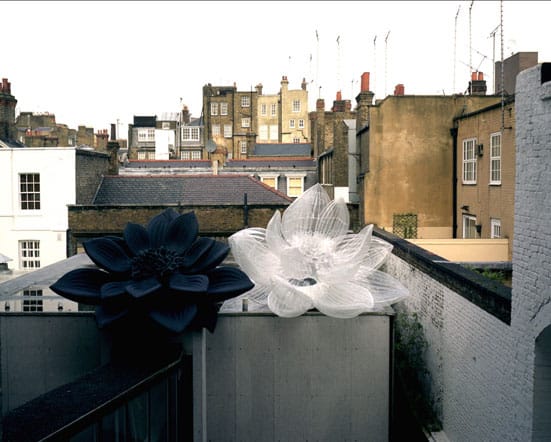23rd November 2006 — 3rd March 2007
A
British tabloid newspaper recently used the Kim Jong-il puppet from
Team America on its front cover to report North Korea's nuclear bomb
test. This suggests a general ignorance about the situation in Korea in
this country, something this exhibition addresses as part of Think
Korea 2006. A beautiful Georgian building on an imposing street off
Portland Place, Asia House is an unusual venue for contemporary art.
Asia House was founded to 'promote appreciation and understanding of
Asian countries ... and to foster closer communication between the
peoples of Asia and Europe'. Many of the works in this exhibition were
created specifically in response to this location. The artists take
over the entire building, subverting the grandiose architecture that
hails from the heyday of Orientalism.
The exhibition's themes of absurdity and whimsy carry political
resonance. Things are not what they seem. The pink flowers in Jiwon
Kim's painting turn out to be the Mendrami flowers that flourish in the
four kilometre demilitarised zone which separates North and South
Korea. The viewpoint is very low and camouflage walls loom in the
background. Obliquely it asks us to reflect on the scar the ideological
division of the Korea has left on its people and culture. The smell of
soap infuses the exhibition. It emanates from Meekyoung Shin's delicate
sculptures. Crouching Aphrodite seems to be a Greek statue in marble,
but is in fact the figure of the artist herself, sculpted in soap. Shin
also presents soap copies of Ming and Qing Chinese vases, these
priceless objects are rendered in a cheap, impermanent material. She is
fascinated by cultural translation between both East and West, and
between neighbouring Eastern countries. She asks the viewer to consider
the implications of the way standards of aesthetic beauty vary through
time and place. In the toilets the visitor is invited to use her golden
Buddha statute as soap when washing their hands. One of its feet is
slightly rubbed away, the result of these semi-devotional acts.
Beom Kim has cut and pasted footage from the Korean Evening News so the
newsreaders are dispensing banal advice to comb your hair, eat regular
meals and get a good night's sleep. The piece passes comment on the
nanny state and the mass media's inoculation of its audience, who now
lack any critical framework with which to view world events. Kyuchul
Ahn has created a domestic structure from abandoned doors. These
obsolete pieces of wood form the walls and roof of a house but are
robbed of their intended use and cannot be opened. Korea's rapid
modernisation, a cycle of building, demolition and rebuilding, means
that recent history is quickly erased, and these doors are all that
remains of the 60s and 70s.
On the surface Korea appears very Westernised, but the influence of its
Eastern neighbours is as crucial, culturally and historically. Yongjin
Kim has created a machine that projects formations of water droplets
onto the wall in beautiful patterns that constantly reconfigure
themselves. Like a microscopic view of cellular activity or an abstract
expressionist painting, but inspired by Buddhist monks practicing
calligraphy with water. Yong-Baek Lee presents a coffee-table-height
glass box, into which heads of Buddha and Jesus Christ, taken from
works of art, are projected alternately. One third of Koreans are
Buddhists and another third are Christian, so these two figures meet on
an equal footing. The serene round face of Buddha contrasts with the
twisted expression of Christ in agony on the cross wearing a crown of
thorns, but eventually they start to merge into one.
Jeong-Hwa Choi's quintessentially Eastern lotus flowers, rendered
in elegant monochrome sit slowly inflating and deflating, as if
breathing, on a rooftop behind Asia House. Choi has also made a long
chandelier out of green plastic baskets to hang down the spiral
staircase. His work humorously reflects on the hybridisation of Western
and Eastern forms in Korean popular culture that is so alien to
Europeans. Sora Kim has reorganised Asia House's library, taking the
books off the shelves and piling them up with the spines to the wall,
so they become abstract white rectangular objects, used sculpturally.
We can't read the books' titles; Kim has stripped them of their
meanings, which she felt reflected a British, potentially colonial,
perspective on Asia. The chairs, mirror and screens have been
rearranged in what seems a most un-feng shui manner, mirror facing the
window that looks out onto the lotus flowers, vaguely sinister against
London's chimney-ed skyline. The visitor is issued with an i-pod
shuffle containing Kim's abstract sound poem as part of the
installation.
Yeondoo Jung displays children's drawings with large photographs in
which he has recreated the scene in 3-D, using handmade props and
costumes and strictly no Photoshop. The results are oddly beguiling;
imagine if the world really looked like this! But they also accentuate
the impossibility of the images and celebrate that they exist purely on
the level of fantasy in the ingenuous imaginations of children. Their
drawings are filled with lurid colours, a vertiginous sense of scale,
no perspective, strange abstract elements and idiosyncratic narratives.
Jung's process of rebuilding the pictures in 'real life' literalises
the children's sketches that we are able to read visually, despite
their technical errors. Snow White lying on a bed, becomes a girl
standing on a ladder in a very long dress in an archway. The attempt to
communicate confronts the conventions of representation. The kids'
drawings mix and match culture references and many share a Disney
aesthetic. For Jung the creation of the tableaux to photograph is a
performative and collaborative act.
AM
Asia House
63 New Cavendish Street
London W1G 7LP
http://www.asiahouse.org/
Open
Monday-Friday, 9am-7pm
Saturday, 10am-6pm

Jeong-Hwa Choi
No Lotus at Asia House 2006
Waterproof material, ventilator,
motor and controller
© Artist Photographer: Gautier Deblonde